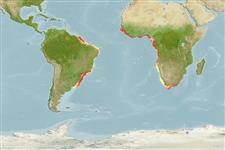Common names from other countries
>
Perciformes/Bembropoidei (Duckbill flatheads) >
Bembropidae (Duckbill flatheads)
Etymology: Bembrops: Greek, bembras, -ados = a kind of anchovy m+ Greek, ops = appearance (Ref. 45335); heterurus: Specific name probably from the Greek 'heteros' meaning different and 'oura' meaning tail..
Environment: milieu / climate zone / depth range / distribution range
экология
морской демерсальный; пределы глубины 50 - 400 m (Ref. 6948), usually 80 - 200 m (Ref. 47377). Deep-water; 12°N -
Western Atlantic: off Rio de Janeiro, Brazil to Uruguay. Eastern Atlantic: Mauritania to the extreme northern waters of Namibia (Ref. 6948, 27121). The eastern Atlantic form referred to as Bembrops heterurus is unlikely to be conspecific with the Brazilian form, thus further taxonomic study is needed to clarify this situation (Ref. 6948).
Size / Вес / Возраст
Maturity: Lm ? range ? - ? cm
Max length : 28.0 cm TL самец/пол неопределен; (Ref. 6948); common length : 20.0 cm TL самец/пол неопределен; (Ref. 2683)
колючие лучи спинного плавника (общее число) : 6; членистые (мягкие) лучи спинного плавника (общее число) : 14 - 15; членистые (мягкие) лучи анального плавника: 16 - 18. Color in alcohol light yellowish to yellowish brown dorsally, light yellowish brown to creamy brown ventrally. Upper lobe of caudal fin elongated at an acute angle. Snout relatively short, 1.0-1.4x eye diameter. Scales on lateral and dorsal surfaces of snout including area in front of eye. Upper jaw extending behind anterior margin of eye but not reaching its mid-line. Maxillary tentacle short. Lateral line descending gradually along dorsal edge of pectoral fin, separated from origin of first dorsal fin by 4 or 5 rows of scales, from origin of anal fin by 6 or 7, and from insertion of anal fin by 3-5. Pectoral fin moderately rounded. Lower lobe truncate or rounded (Ref 13203).
Found on soft bottoms of the continental shelf and feeds on crustaceans and fishes (Ref. 3656).
Life cycle and mating behavior
Maturities | размножение | Spawnings | Egg(s) | Fecundities | личинки
Das, M.K. and J.S. Nelson, 1996. Revision of the percophid genus Bembrops (Actinopterygii: Perciformes). Bull. Mar. Sci. 59(1):9-44. (Ref. 13203)
Статус Красного Списка МСОП (Ref. 130435)
CITES (Ref. 128078)
Not Evaluated
Угроза для людей
Harmless
Использование человеком
рыболовство: коммерческий
дополнительная информация
инструменты
Warning: mysqli::__construct(): (08004/1040): Too many connections in /var/www/html/includes/speciessummary.lib.php on line 2104
Can't connect to MySQL database fbquizv2. Errorcode: Too many connections
